Communicating your youth work: Data protection, safeguarding and increasing visibility
Communicating your youth work: Data protection, safeguarding and increasing visibility
- EUROPARC Webinar
- 06.03, from 14:30 – 16:00 CET
- Attendance is free, but registration is necessary
Showcasing the importance of involving young people in Protected Areas is crucial to influence perceptions of decision-makers, local cummunities and colleagues. In this webinar, we have three experts sharing their knowledge with you, to grow your confidence and help you increase the visibility of the work you do with young people in Protected Areas through school visits, family days, the Junior Ranger and Youth+ Programmes, in a safe and compliant way.
Our first speaker, Ilaria Pizzini, a compliance expert from Italy, will introduce us to the data protection regulations. After this presentation, everyone should feel comfortable, knowing how to be mindful of data protection and what goes into a parental consent form.
Our second speaker, Lou Willis-Keeler, is the CEO of Psych-Logical LTD, a consultancy advising organisations in the UK on how to work with young people. For this session, she will be sharing the every-day human experiences of communicating with young people to ensure everyone feels safe and is aware what to do if they don’t.
Our last speaker, Franciska Maarse is a communications officer from IVN Natuureducatie in the Netherlands. She will be sharing many tips and tricks to help you increase the visibility of environmental education across different platforms.
Join the webinar to learn, ask questions or share concerns and experiences. We welcome you to share this invitation with your colleagues.
Webinar Programme
Welcome and Introductions
Jessica Micklem-Kolenić, Youth Officer at EUROPARC Federation.
Youth and Data Protection: Rules, Tips and Tricks
Ilaria Pizzini, Data Compliance Expert
Q&A
Creating a Safe Space for All
Lou Willis-Keeler, CEO of Psych-Logical LTD
Q&A
Increasing and Improving Visibility
Franciska Maarse, Communications Officer, IVN Natuureducatie
Q&A
The webinar will last 1.5 hours
About the speakers

Ilaria Pizzini, Data Compliance Expert
Ilaria has worked for many international organisations and industries, i.e. Coop (Modern Retailing), Xerox, Datamat, Digital Equipment (Information Technology), and in particular in UNICEF Italian NatCom where she managed the transition from Italian privacy regulations to the EU’s General Data Protection Regulation (GDPR) from the perspective of processes, systems, procedures and documentation. She holds a Masters degree from LUISS Business School in Governance in Privacy, is a qualified Data Protection Officer with much experience in both human resources and complaince (including, data protection, safety and security etc.).

Lou Willis-Keeler, CEO of Psych-Logical LTD
Lou is a specialist safeguarding and behavioural change consultant, working in the informal education sector. With over 20 years practice based experience and a Masters Degree from Durham University in Community and Youth Work, Lou works with organisations to help them create safe spaces for teaching and learning, improving engagement and increasing impact.

Franciska Maarse, Communications Officer, IVN Natuureducatie
Franciska is the communications officer of IVN Natuureducatie, a non-profit nature education organisation based in Amsterdam. She focusses on communication around youth programs of all ages and has a background in sustainable behavior change and psychology. Her passions include writing, designing, storytelling (and when out of the office; singing).

AND SO IT BEGINS! EUROPEAN NATURE ACADEMY Induction Meeting in Schneverdingen, Germany
ENA Induction Meeting
From 13 to 17 February, LIFE ENABLE launched the European Nature Academy (ENA). 59 Natura 2000 and Protected Area managers from 24 countries gathered in Schneverdingen, Germany!
The event was hosted by LIFE ENABLE project partner, Alfred Toepfer Akademie für Naturshutz.
The meeting introduced the ENA platform, which will offer online competence-based courses and capacity-building opportunities, especially for managers of Forests and Marine ecosystems. The courses are designed to provide a range of tailor-made modules that will enable Natura 2000 and Protected Area managers to become more effective, confident and competent practitioners in their everyday work.
Networking the ENA participants
The Induction meeting was designed to bring the first intake of ENA participants together. The 3-day programme included a variety of interactive sessions to let participants get to know each other, connect and share their experiences from the Natura 2000 sites and Protected Areas that they manage.
Through a World Café, participants introduced themselves and each other to their places of work and compared management challenges and practices.
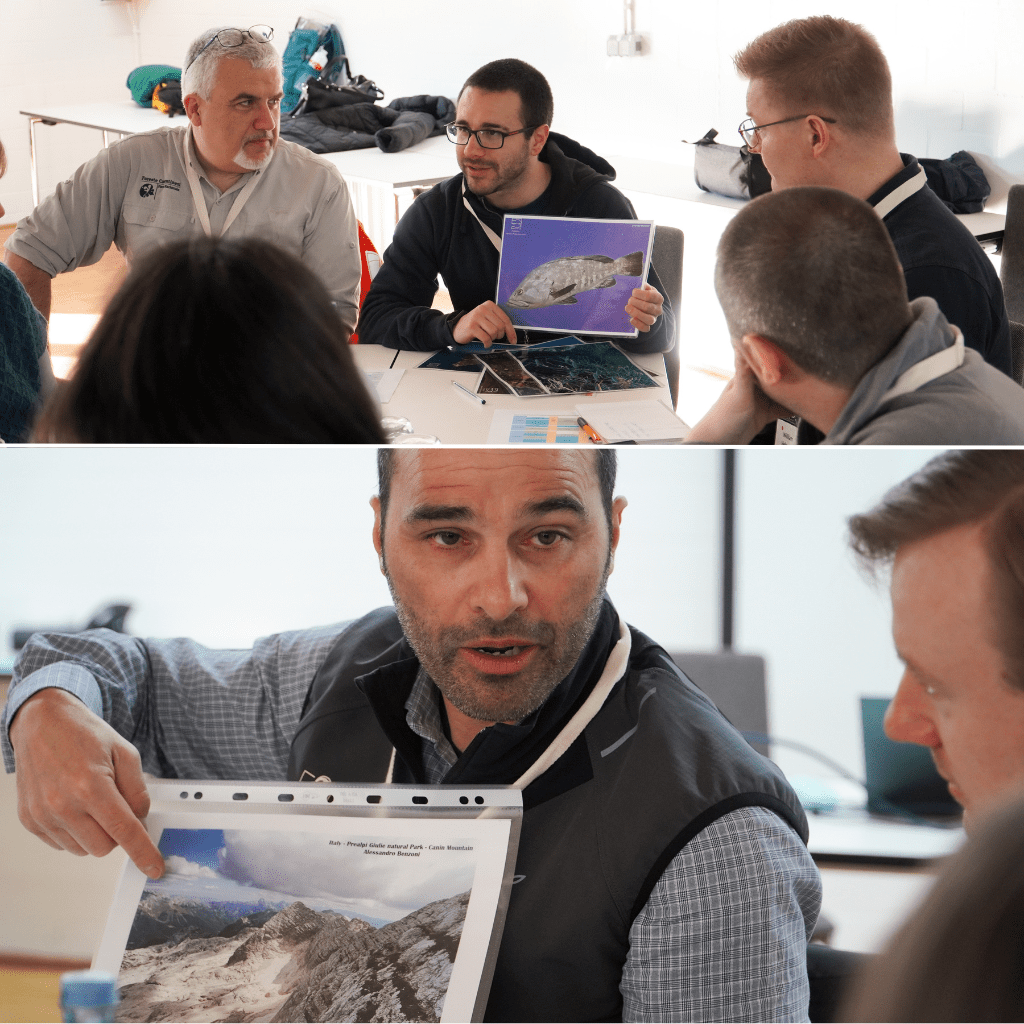
ENA Induction Meeting World Café
Learning Styles
Participants compared their preferred Learning Styles – whether people learn more visually, aurally, by reading, by kinaesthetic means or in multimodal ways – understanding the different ways individuals learn will be useful for the rest of their ENA journey.
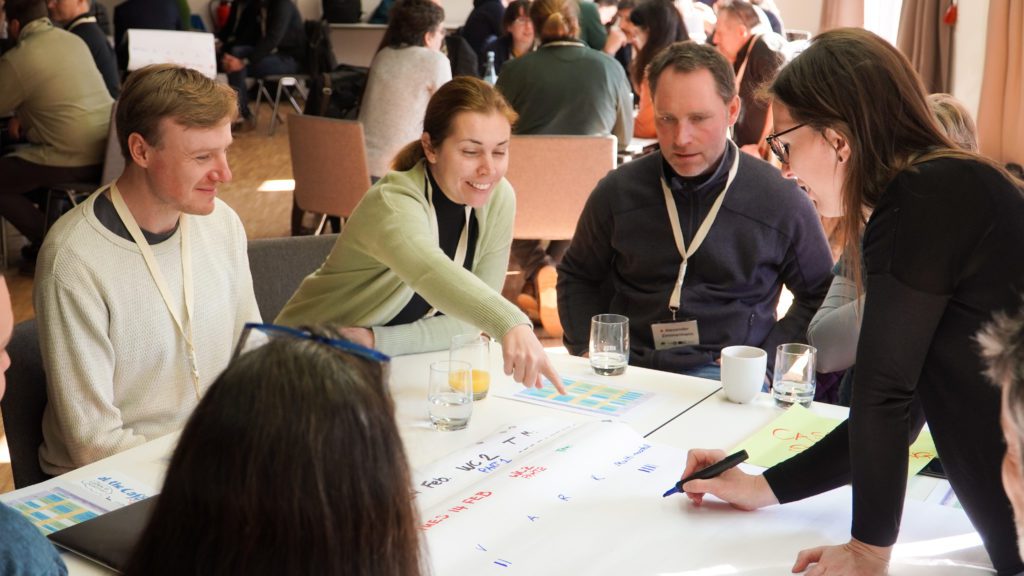
ENA Induction Meeting Learning styles
Interactive sessions
Multiple interactive sessions enabled participants to unwrap core competencies that apply in their work, including Personal Communication Competencies, Communication Tools & Social Media, and Written & Presentation skills.
Furthermore, participants practised using the new Training Needs Assessment Tool developed by LIFE ENABLE project partners, ProPark.
Additionally, they were introduced to the European Nature Academy platform, Marine, Forest and Train the Trainers Courses.
Working as teams
To facilitate collaboration and co-learning, participants were allocated to sub-groups, which we have called learning ‘PODs’. Working in their PODs, they worked through the Impact Assessment Exercise on Thursday – having completed the exercise’s 4 steps, each POD prepared and presented the results of their work.
Meet our nine ENA PODs:
1. Adaptive Seagulls
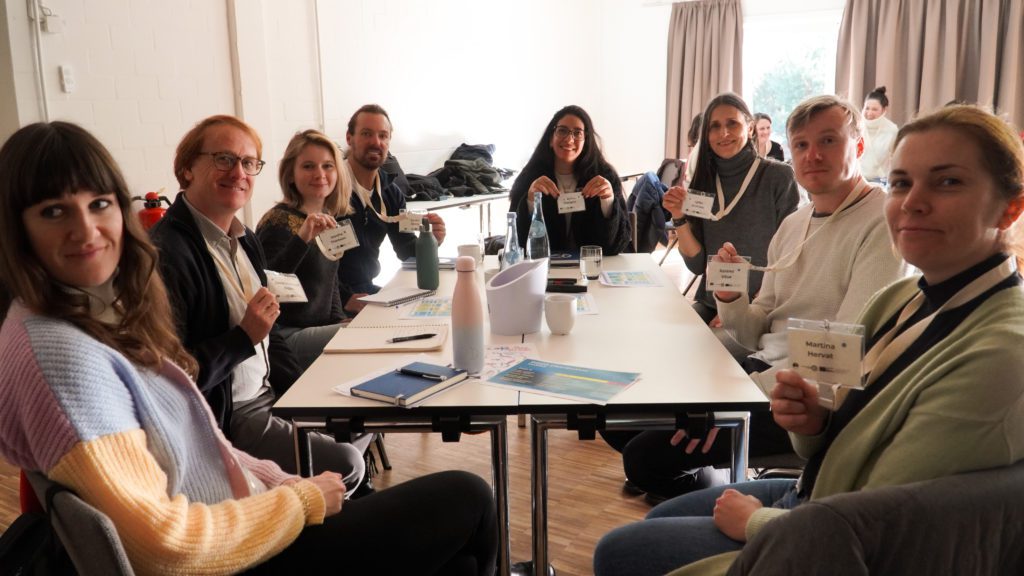
ENA POD Adaptive Seagulls
2. For-rest
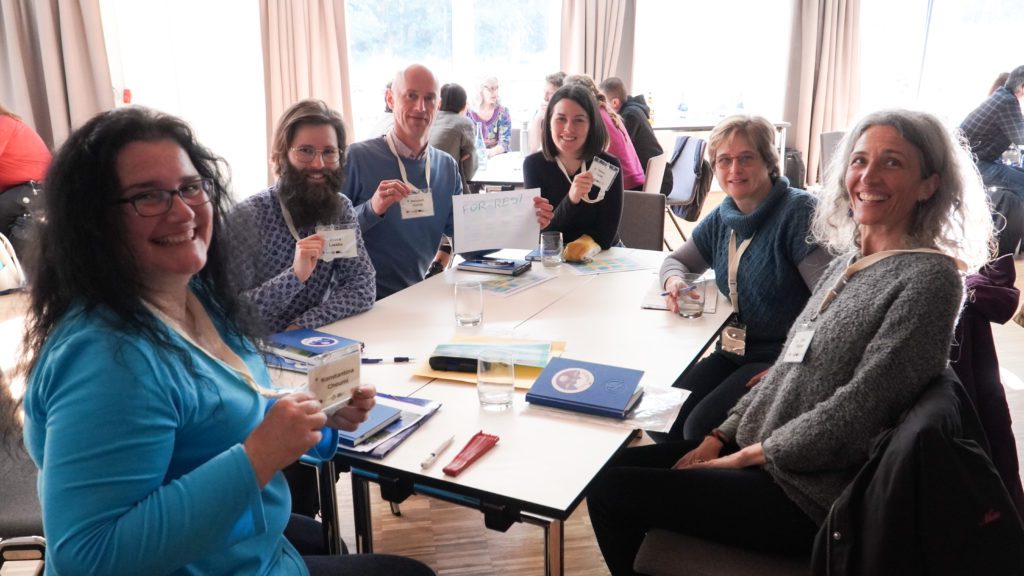
ENA POD For-rest
3. Forest Gump
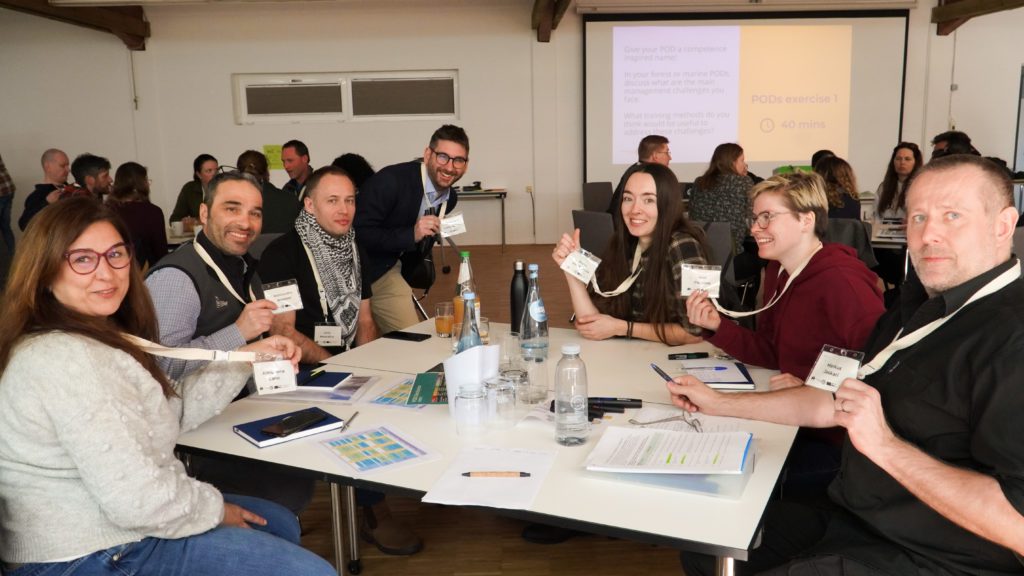
ENA POD Forest Gump
4. Resilient Forest
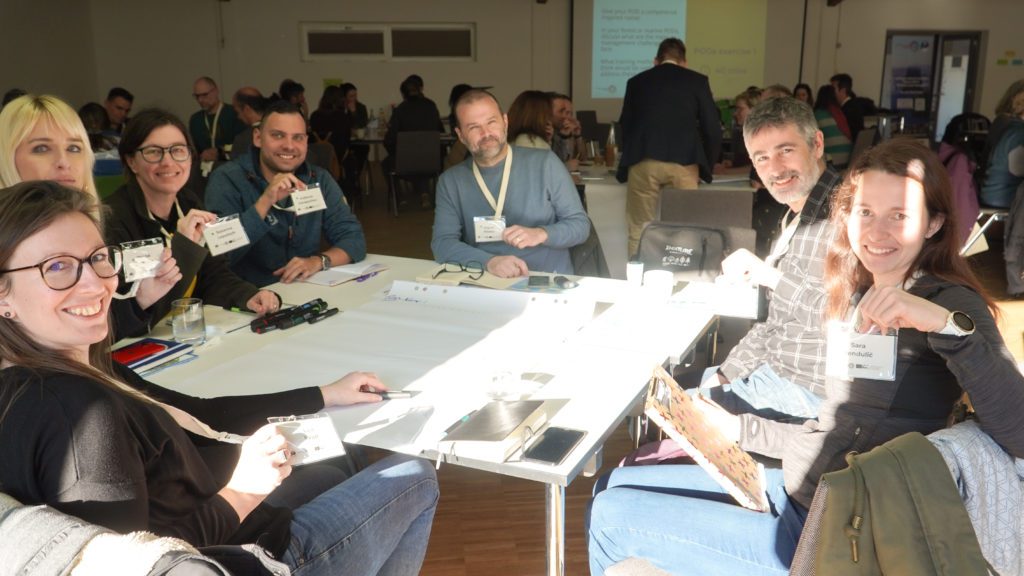
ENA POD Resilient Forest
5. Forest Navigators
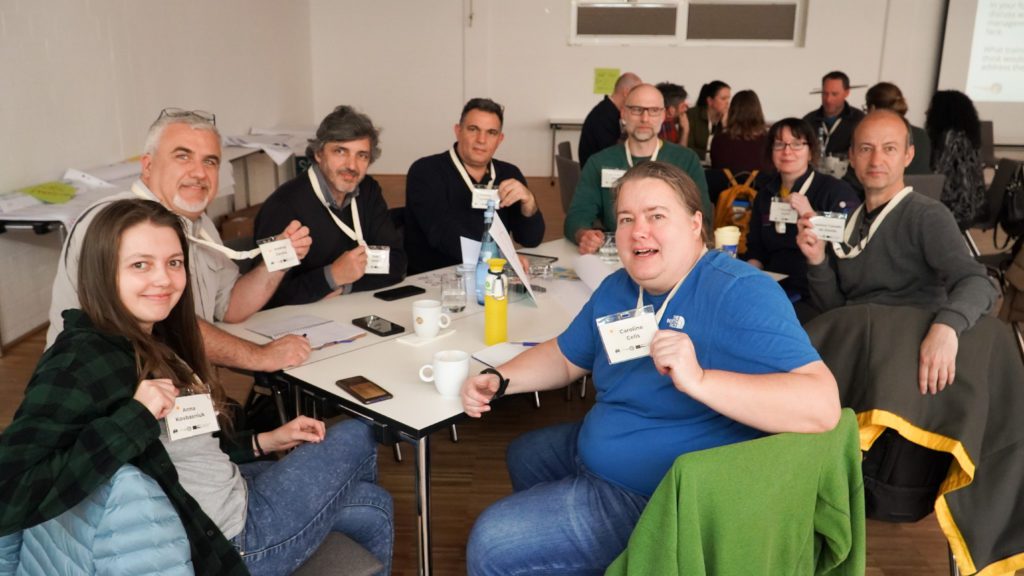
ENA POD Forest Navigators
6. Power of Diversity
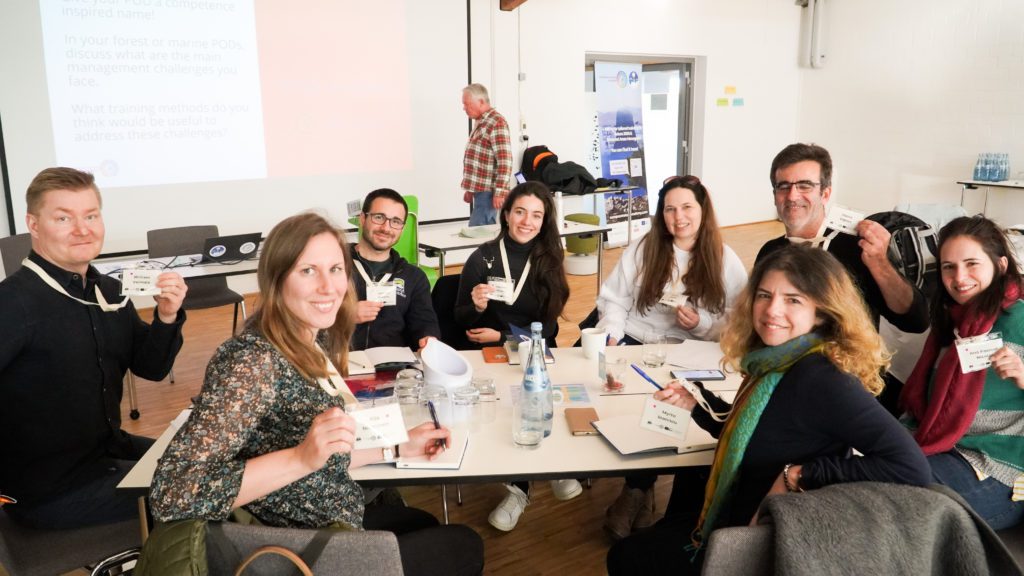
ENA POD Power of Diversity
7. Yellow Submarine
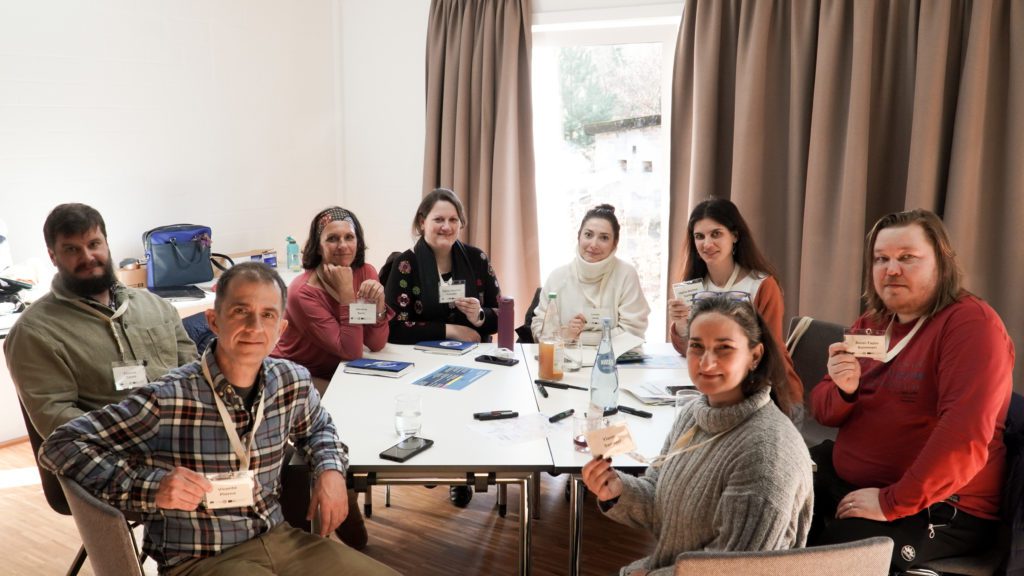
ENA POD Yellow Submarine
8. We Can! (We, Culture and Nature)
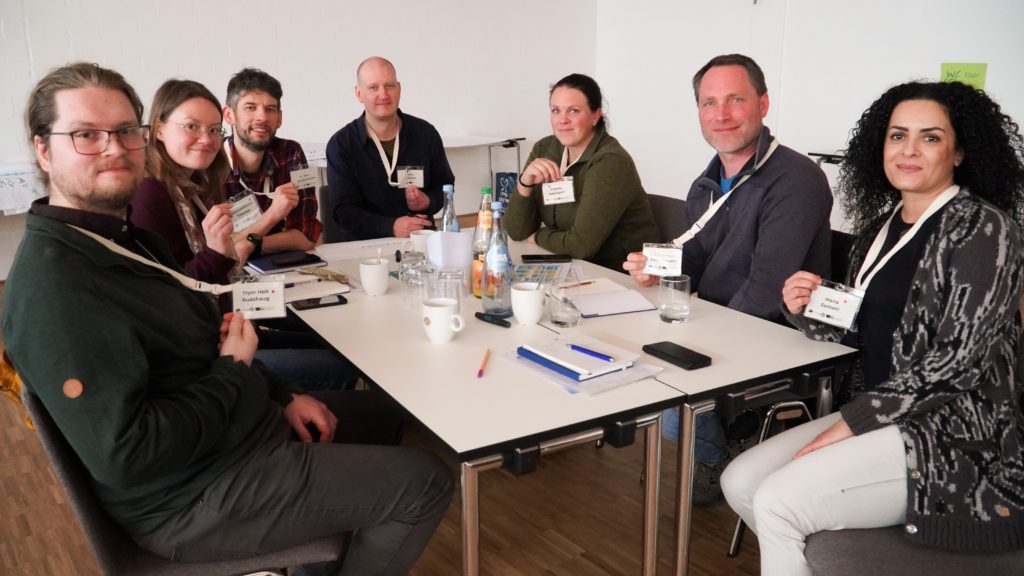
ENA POD We Can!
9. Oak
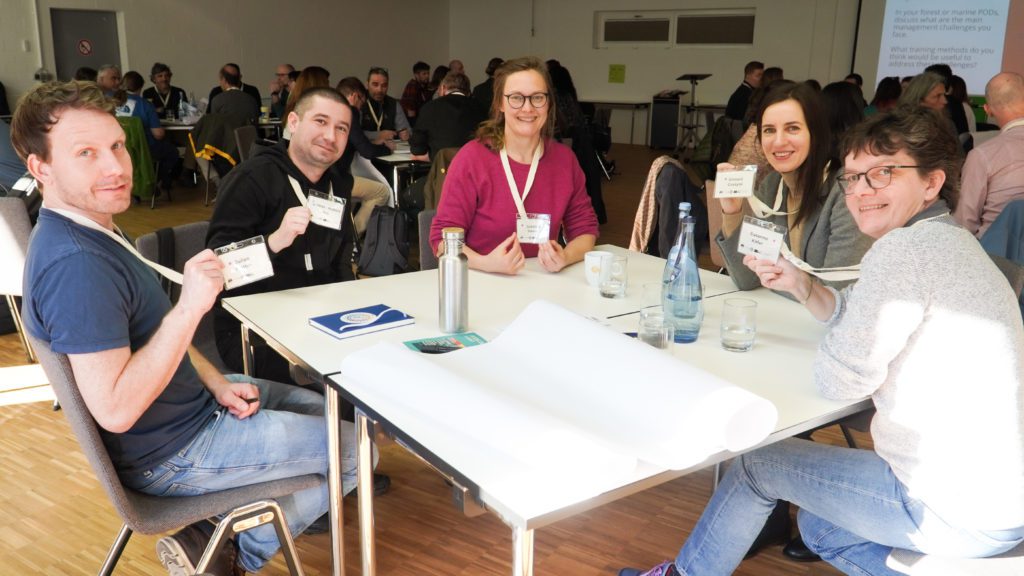
ENA POD Oak
The best is yet to come!
Based on the pure energy, positive enthusiasm and hunger to learn so openly evident in the Induction meeting, we could not have asked for a better start to the European Nature Academy.
It is already clear that the connections being initiated by the ENA will last long beyond the LIFE ENABLE project’s duration.
We whole-heartedly thank all our ENA-ers for their commitment and positivity and wish each and every one of them huge success in their professional development as they embark on their ENA journey.
Creating Memories
Make sure to check out the highlights from the Induction Meeting in a short video and photo album:
New EU Action Plan to restore marine ecosystems for sustainable and resilient fisheries
IJmuiden, 25-26 March 2002. A fishing boat leaves the port of IJmuiden to go fishing in the North Sea. The nets are hauled in to recover the catch. Photo by Jan van de Vel - European Communities, 2002.
Yesterday March 21st, the European Commission published the Action Plan: Protecting and restoring marine ecosystems for sustainable and resilient fisheries as part of the set of measures aiming to improve the sustainability and resilience of the EU´s fisheries and aquaculture sector.
Towards lower impact fisheries and sustainable stocks
This action plan has been designed to reinforce the support provided by the Common Fisheries Policy´s to guarantee that healthy fish stocks and rich biodiversity levels are sustained in time in our oceans. The main actions presented aim to reduce the negative impacts of fishing activities on the marine ecosystems, especially those related to by-catch of sensitive species and its consequent effects on the marine food webs, and increase the selectivity of fishing gears.
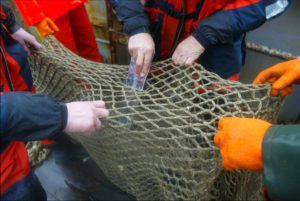
IJmuiden, 25-26 March 2002.
Coast Guards and Official Control Inspectors set out to control fishing vessels in the North Sea.
The inspectors control the net the fishermen use. Photo by Jan van de Vel – European Communities, 2002.
Additionally, the action plan will contribute to the objectives of the recently agreed Kunming-Montréal biodiversity agreement and in delivering the EU Biodiversity 2030´s environmental targets so the EC calls all Member States to put into place adequate fisheries conservation measures to effectively manage Marine Protected Areas. These measures should embrace actions to protect fish spawning and nursery areas, reduce fish mortality rates and restore core areas for sensitive species and habitats.
On another line, the action plan aims to decrease seabed disturbances originated by fishing apparels in MPAs and the Commission calls Member States to progressively reduce mobile bottom fishing in all MPAs by 2030, as well as to forbid it in newly established MPAs. It is noteworthy that the seabed habitats comprised within MPAs play a pivotal role in the protection of marine biodiversity, as they often constitute biodiversity hotspots, and act as blue carbon reservoirs that are very needed in tackling climate change impacts.
Other measures to improve EU’s fisheries and the aquaculture sector
Together with the Action Plan: Protecting and restoring marine ecosystems for sustainable and resilient fisheries three other elements that conform the package of measures presented by the European Commission are been presented:
- a Communication on the Energy Transition of the EU Fisheries and Aquaculture sector;
- a Communication on the common fisheries policy today and tomorrowand
- a Report on the Common Market Organisation for fishery and aquaculture products.
These other measures aim to promote the use of cleaner energy sources, such as renewable and low-carbon power sources, and reduce the dependency of the fishing sector on fossil fuels, making it less vulnerable to increases in energy prices. The main goal of this energy transition is to reach climate neutrality by 2050, as it is reflected in the European Green Deal. In this context, an Energy Transition Partnership for EU Fisheries and Aquaculture it is being proposed in order to bring together all stakeholders to collectively address the challenges this transition entails.
Additionally, the Commission proposes the creation of a ‘Pact for Fisheries and Oceans”. Since the CFP constitutes the main legal framework to address the challenges that EU fisheries and the seas and, as of today, several obstacles to achieve its full implementation remain in place, this pact will bring together all stakeholders and the Commission in order to tackle them. The pact will allow to open a dialogue between the parts, build common understanding of the objectives to be achieved and help adapt the CFP where necessary.
Much of our economy depends on nature. Fisheries are quite possibly the sector where this link is most direct. Europe’s marine ecosystems and the fish, shellfish, algae, and plants that are part of them are crucial to the economic viability of fisheries. With these proposals we aim to build a sustainable relationship with our seas. The European Commission will work with local fishing communities, the aquaculture and fisheries sector and help them adopt sustainable practices, from reducing energy usage to using more selective fishing gear. As part of efforts to restore and protect nature, we also ask Member States to phase out bottom trawling in fragile areas. When we ensure the sustainability of fisheries we invest in the resilience and future of the sector and its workers. Working together, we can find the right balance and establish healthy marine ecosystems all over Europe -Frans Timmermans, Executive Vice-President for the European Green Deal – 21/02/2023
Resources of interest
For a quick overview on the Actions for sustainable and resilient fisheries, aquaculture and marine ecosystems, visit this Factsheet.
For detailed information on the four elements that conform the Commision´s package of measures to improve the sustainability and resilience of the EU’s fisheries and aquaculture sector, please visit the documents below:
EU Action Plan: Protecting and restoring marine ecosystems for sustainable and resilient fisheries
Communication on the common fisheries policy today and tomorrow
Report on the results of Common Market Organisation for fishery and aquaculture products
Takeaways from IMPAC5 – the 5th International Marine Protected Areas Congress, Canada.
Syexwáliya Ann Whonnock, Squamish Nation elected counsilor - IMPAC5. Photo by IISD/ENB | Anastasia Rodopoulou.
The congress embraced relevant topics such as communities, youth and indigenous peoples´ involvement, sustainable financing for MPAs, sustainable fisheries and several aspects on MPA governance and management.
From February 3rd to the 9th, the 5th International Marine Protected Areas Congress (IMPAC5) opened its doors in Vancouver, Canada. This global forum aims to engage ocean conservation professionals, youth delegates, Indigenous Peoples, authority representatives and other stakeholders from all over the world to exchange knowledge, experiences and best practices to strengthen the conservation of marine biodiversity and the protection of the ocean.
Hosted in the traditional territories of the First Nations’ Squamish, Musqueam, and Tsleil-Waututh Nations, the congress had a strong presence of First Nations and Inuit representatives, who reminded us all that Canada is an ocean nation, with the longest coastline in the world and that protecting of marine ecosystems is key for the nation’s survival. During the opening and in this same line of thought, it was emphasized the vital role that oceans play in people’s lives, both for the services they provide to our society (1) and the deep connection that exists between the ocean and Canada’s culture and economy (2).
The opening ceremony also highlighted that the congress is an official activity of the UN Decade of Ocean Science for Sustainable Development and a contributing act for the implementation of the recently adopted Kunming-Montreal Global Biodiversity Framework.
The Kunming-Montreal Global Biodiversity Framework
The recently agreed upon Kunming-Montreal Global Biodiversity Framework is an important step for global conservation. This framework aims to halt and reverse biodiversity loss and covers marine areas within national jurisdiction and, in the congress, it was recognised as “the most important universal agreement we have”, while it was underscored that there cannot be a healthy planet without a healthy Ocean, and that its health is in decline (3).
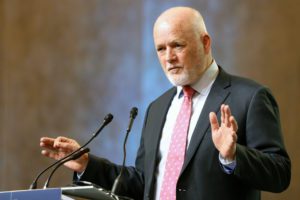
Peter Thomson, UN Secretary-General’s Special Envoy for the Ocean – IMPAC5. Photo by IISD/ENB | Anastasia Rodopoulou.
One particular target includes the commitment to protect 30% of the oceans by 2030 (also known as 30×30). However, this is an incredible challenge, as it implies expanding to almost triple the current Marine Protected Areas (MPAs) in the next seven years (4).
In this line, a specific discussion took place on the efficacy of a 30% area target based on a case study on MPAs in the German North Sea, underlining that each MPA is subject to different stressors and therefore requires specific management solutions (5). However, a reminder of our existing lack of knowledge and understanding of extense areas of the oceans such as the high seas and the deep seas, and the necessity to create MPAs on these areas and around the Antarctic, was also presented together with a call to think beyond the 30×30, as protecting 30% of the planet is not going to solve all the world’s problems (6).
Community involvement – Empowering communities to lead the way

Sylvia Earle, Founder and Co-Chair, Mission Blue 1 – IMPAC5. Photo by IISD/ENB | Anastasia Rodopoulou.
Local communities, specifically indigenous communities as the hosts of the land on which the congress took place, were undoubtfully another key topic during the congress. Both local communities and small-scale fisheries have a key role in leading the way on environmental stewardship and marine conservation (7) and it is crucial to incorporate their perspectives and knowledge (8).
The benefits of empowering communities to participate and collaborate in the conservation of resources and livelihoods, as well as to achieve a sustainable management, were also presented through examples from Myanmar (9) and Tanzania (10). Other interesting cases about community led initiatives were presented: A community led coral conservation and restoration activities that include the certification of community coral gardeners in San Andrés, Colombia (11); A monitoring and reporting framework on a marine reserve developed in cooperation with indigenous people in New Zealand (12); An ongoing process to develop a community-based MPA in this southern Chilean archipelago (13).
Sustainable Finances and Sustainable Tourism in MPAs
The integration of science and community-based approaches were also identified as a solution to improve the management and financial sustainability of the MPAs (14). Other examples of blue finance solutions were presented from Onnason, Okinawa, on a mozuku seaweed farming and coral plantation (15).
Sustainable Tourism was also integrated in the conversations. From a financial point of view, an example on the development of a business model based on raising revenue from sustainable tourism in order to support the budget of the Turneffe Atoll Marine Reserve was presented (16). As a counterpart, the efforts undertook to limit the negative to regulate diving tourism in Karimunjawa National Park in the Java Seas, Indonesia, were explained and reminded the participants the negative impacts that tourism activities can pose to marine ecosystems (17).
Challenges in MPA Management and Governance
Some interesting reflections on MPA management and its challenges were brought to the discussion. It is noteworthy to mention the presentations submitted about Gwaii Haanas National Park in Canada, covering an overview of its history over the last 30 years and its main challenges and solutions. In this regard, some conclusions on research studies on measuring co-development of governance indicators to support the implementation of a landsea-people plan in this Park were exposed (18).
Other factors underpinning MPA management were identified as social, economic and ecological elements, as explained in a case study on the management of San Antonio MPA (19). Likewise, , social acceptance of MPAs was identified as another barrier in its implementation and, based on the research outcomes on a generic MPA model, it was concluded that many times the opposition to MPAs is not against conservation, but rather the design and implementation model used (20).
On the other hand, Transboundary Cooperation was also present in the discussion with an example on Transboundary Protected Areas management in the Eastern Tropical Pacific in which the importance of enabling the harmonization of different legal, political, and cultural systems and the necessity to develop of a stronger legal framework for “ecological connectivity” were underscored (21).
Another case study in this line was brought on the work of a civil society network for the conservation of the Patagonian Sea, the challenges they face, and how views should be standardized between decision-makers of different countries to reach effective protection when management extends beyond country boundaries (22).
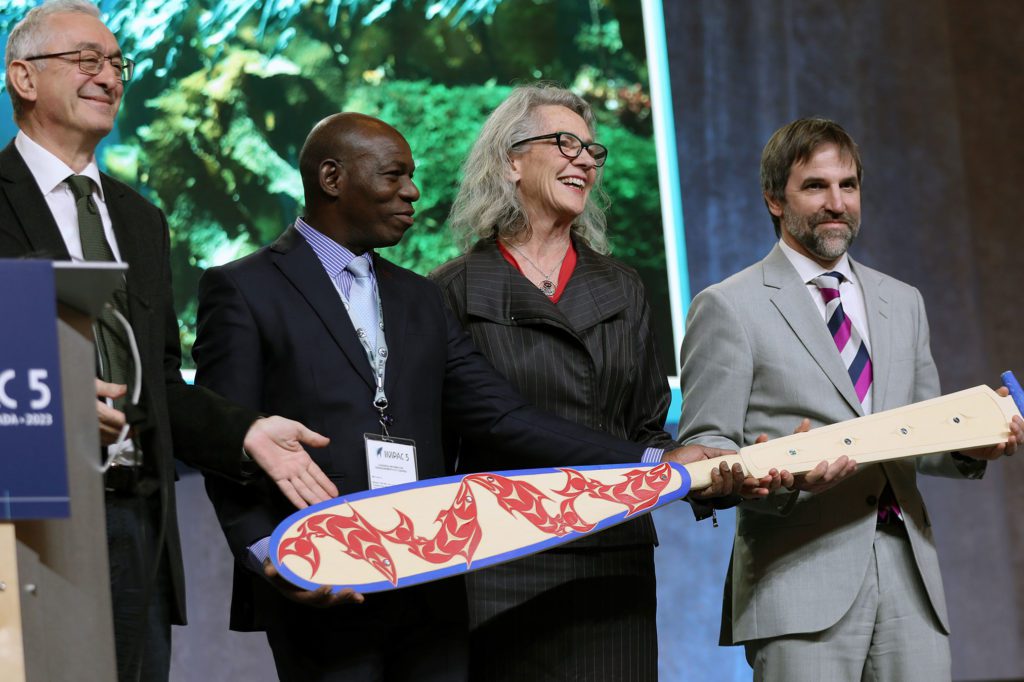
L-R: Bruno Oberle, Director-General, International Union for Conservation of Nature, Mamadou Sidibé, Director of Community Marine Protected Areas, Senegal, Joyce Murray, Minister of Fisheries, Oceans, and Canadian Coast Guard, and Steven Guilbeault, Minister of Environment and Climate Change, Canada – IMPAC5. Photo by IISD/ENB | Anastasia Rodopoulou.
The importance of Other Effective area-based Conservation Measures (OECMs)
As it was underscored during the congress, OECMs present a unique opportunity for stakeholders to get involved in conservation measures. In this regard a case study on the Baltic Sea in relation to the role of the Regional Sea Conventions, highlighting the need of a cross-sectorial approach to interpret the OECM criteria, was presented (23).
Additionally, reflections on the need to bring the socio-economic sectors into the conservation discussion, to clarify to all stakeholders the differences between MPAs and OECMs (24), the necessity of a clearer understanding of the identification process of OECMs (25) and the facilitating role that NGOs can have were also made (26).
Youth involvement

Sean Russell, IMPAC5 Young Professionals Committee – IMPAC5. Photo by IISD/ENB | Anastasia Rodopoulou.
Youth and their involvement in marine conservation was also one of the topics that stood out during the conference and an IMPAC5 Youth Call to Action was presented during the congress, advocating for a set of youth-determined priorities (27).
Furthermore, the work carried out by Connect to Protect initiative which aims to build a digital community and encourage youth leaders to join the GenSea network to collaborate and nurture a community of youth ocean advocates was exposed (28). Panellists were also invited to reflect on several questions encompassing empowering youth in organizations and hiring them (29).
Further mentions to youth involvement were done in regards of the importance of creating opportunities for children in the school system (30), and of facilitating ways young people can contribute in culturally relevant ways (31).
If you are interested to learn more, we suggest reading the Earth Negotiations Bulletin and listening to the Protecting Blue Nature podcast series.
References to the speakers mentioned in this article can be found below:
(1) Joyce Murray, Minister of Fisheries, Oceans, and the Canadian Coast Guard, Canada.
(2) Amandeep Singh, British Columbia Parliamentary Secretary for Environment, Canada.
(3) Peter Thomson, UN Secretary-General’s Special Envoy for the Ocean, Fiji.
(4) Fanny Douvere from UNESCO’s World Heritage Marine Programme, France.
(5) Benne Wölfing, German Federal Agency for Nature Conservation, Germany.
(6) Sylvia Earle, ocean activists and National Geographic Explorer, United States.
(7) Anthony Charles, Saint Mary’s University, Canada.
(8) Nathalie Ban, University of Victoria, Canada.
(9) Zau Lunn, Flora and Fauna International (FFI), Myanmar.
(10) Tanguy Nicolas, MWAMBAO Coastal Community Network, Tanzania.
(11) Pablo Caldas, Conservation International, Colombia.
(12) Monique Ladds, New Zealand Department of Conservation, New Zealand.
(13) Enrique Higueras, Municipality of Las Guaitecas, Chile.
(14) Grace Gatapang, Blue Alliance Philippines, Philippines.
(15) Masanori Kobayashi from the Sasakawa Peace Foundation, Japan.
(16) Valdemar Andrade, Turneffe Atoll Sustainability Association, Belice.
(17) Rohmani Sulisyati, Karimunjawa National Park, Indonesia.
(18) Ella-Kari Muhl, University of Waterloo, Canada.
(19) Veronica Relano, University of British Columbia, Canada.
(20) Anne Cadoret, Aix-Marseille University, and Jean-Eudes Beuret, Rennes Agro Institute, France.
(21) Sarah Enright, University College Cork, Ireland.
(22) Catherine Dougnac, Wildlife Conservation Society, Chile.
(23) Jannica Haldin, HELCOM, Finland.
(24) Souha El Asmi, UNEP-MAP, Tunisia.
(25) Felipe Paredes, Ministry of Environment of Chile.
(26) Johnny Briggs, The Pew Charitable Trust, United Kingdom.
(27) Sean Russell, IMPAC5 Young Professionals Committee, Canada.
(28) Amelia Fortgang, EarthEcho, United States.
(29) Joseph Mcleod, Parks Canada, Canada.
(30) Jenn Stevens, Learning for Sustainable Futures, Canada.
(31) Joshua Komangapik, Students on Ice, Canada.